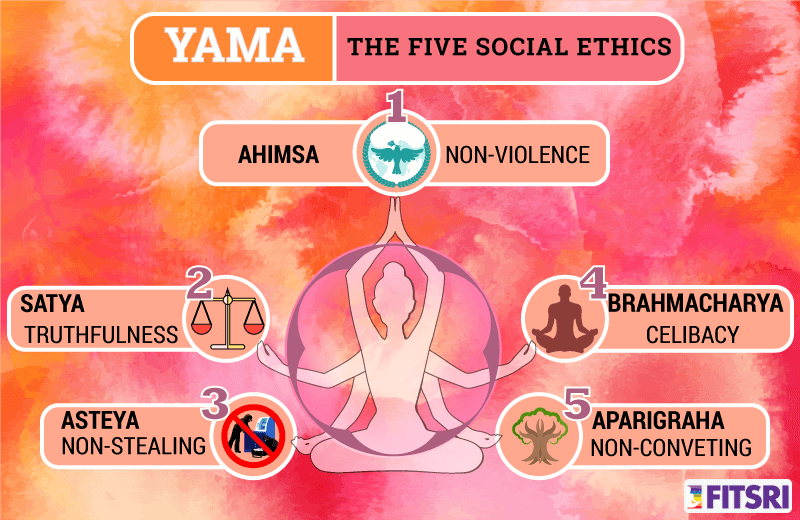
Yoga is not only a bodily observe but additionally a path to religious and emotional well-being. The traditional sage Patanjali’s Yoga Sutra, written round 200 CE, presents a complete information to a holistic method to yoga. Considered one of its key ideas is the Eight Limbs of Yoga, which incorporates moral tips for practising yoga and residing a wholesome life often known as the Yamas.
The Yamas are the first limb of the Eight Limbs of Yoga and are thought of the inspiration of all the yoga observe. They’re a set of ethical and moral ideas that information a yogi’s behaviour in direction of themselves and others.
On this article, we are going to discover the Yamas in additional element and share sensible tips about easy methods to incorporate them into each each day life and yoga observe. By the top, you’ll have a clearer understanding of the Yamas and their significance in each yoga and on a regular basis residing.
What’s the which means of Yamas?
Yamas are a set of 5 moral tips that kind a vital a part of the observe of yoga. The time period yamas comes from the Sanskrit phrase yam, which implies “to restrain” or “to manage.”
In yoga philosophy, the Yamas are sometimes described as a set of “don’ts” issues one ought to chorus from doing. Nonetheless, they’re extra than simply guidelines to observe; they’re guiding ideas that lead us in direction of a extra aware and compassionate way of life.
The aim of practising the Yamas is to develop self-control and domesticate ethical self-discipline. By following these moral tips, a yogi can purify their ideas and actions, resulting in a extra conscious and compassionate life.
Practising the Yamas additionally helps create harmonious and peaceable relationships with others, selling unity, respect, and understanding in each day interactions.
Distinction between yamas and niyamas
The Yamas shouldn’t be confused with the Niyamas, that are the second limb of yoga. Whereas the Yamas educate us easy methods to work together with the world round us, the Niyamas deal with how we are able to enhance ourselves from inside. The Yamas information our behaviour in direction of others, whereas the Niyamas assist us domesticate self-discipline and help religious development.
Collectively, the Yamas and Niyamas kind a set of ten ethical codes of conduct, providing ideas for residing a significant and purposeful life each on and off the mat.
What are the 5 yamas in yoga?

The 5 Yamas are talked about in Chapter 2 (Sadhana Pada), Verse 30 of the Yoga Sutra by Sage Patanjali. In response to Patanjali’s Eight Limbs of Yoga, the 5 Yamas are:
- Ahimsa (non-violence)
- Satya (truthfulness)
- Asteya (non-stealing)
- Brahmacharya (celibacy)
- Aparigraha (non-greed)
The Yamas take care of our behaviour and actions that have an effect on our relationship with the outer world. For that reason, they’re sometimes called ideas of self-restraint or the “don’ts” in yoga.
Every Yama may be understood as a aware restraint from frequent detrimental tendencies and the cultivation of their reverse, optimistic qualities. For instance:
- Himsa (violence or hurt in direction of oneself or others) is countered by Ahimsa, practising non-violence and kindness towards all beings.
- Asatya (falsehood or dishonesty) is changed by Satya, being truthful in thought, speech, and motion.
- Parasteya (stealing or taking what just isn’t freely given) is restrained by Asteya, which implies not stealing and respecting others’ belongings.
- Overindulgence or immoderation is restrained by way of Brahmacharya, the observe of self-control and moderation.
- Aparigraha means letting go of greed, attachment, and hoarding, selling simplicity and contentment.
These ideas encourage yogis to purify their ideas and actions, serving to them develop mindfulness, compassion, and moral residing.
Yamas in Hatha Yoga Pradipika
Whereas Patanjali’s Yoga Sutra lists 5 Yamas, the Hatha Yoga Pradipika outlines ten Yamas. Curiously, this textual content excludes Aparigraha and consists of extra moral disciplines. In response to Hatha Yoga Pradipika, the ten Yamas are:
- Ahimsa (Non-violence)
- Satya (Truthfulness)
- Asteya (Non-stealing)
- Brahmacharya (Celibacy)
- Kṣama (Forgiveness)
- Dhrti (Fortitude, perseverance, braveness)
- Daya (Compassion)
- Arjava (Sincerity)
- Mitahara (Measured food plan)
- Shoucha (cleanliness)

The primary of the 5 Yamas is Ahimsa, the moral observe of non-violence or non-harming—in direction of oneself, others, and nature in ideas, phrases, and actions.
The phrase Ahimsa comes from Sanskrit, the place the prefix “a” means not, and “himsa” means harming, injuring, killing, or committing violence.
Ahimsa may be understood by way of three core ideas:
- Refraining from inflicting hurt to others, oneself, or nature—bodily or emotionally.
- Avoiding detrimental or dangerous ideas about others or oneself.
- Making certain our actions and angle foster peace and cut back struggling.
By adopting an Ahimsa mindset, we nurture self-love and open our hearts to all residing beings. This internal compassion fosters empathy, dissolves dangerous tendencies, and encourages us to stay in concord with life itself.
Methods to observe ahimsa (Non-violence)
- Domesticate Compassion: Make an effort to deal with your self and others with extra compassion, acceptance, and forgiveness.
- Conscious Yoga Apply: Protecting Ahimsa in thoughts whereas doing yoga helps us to let go of detrimental physique picture ideas and embrace ourselves solely, regardless of how agile or sturdy we’re at present.
- Take heed to Your Physique: Spend a while in every place observing how your physique feels and what it wants. You possibly can keep away from damage and full your observe whereas giving your physique the precise vitamins it requires on this method.
- Steadiness and Moderation: Whereas Ahimsa promotes avoiding killing one other residing being, and therefore refraining from consuming animals, there should be a steadiness. It’s essential to take into consideration what features greatest if eliminating particular meals out of your food plan harms you.
- Optimistic Considering: Our common well-being is drastically influenced by our ideas as nicely. Not solely ought to we concentrate on what we expect, but additionally of these of others. Even when meant at another person, bitterness, hatred, and jealousy solely serve to make us really feel depressing.
Additionally learn: 8 actionable methods to observe Ahimsa in each day life

The idea of Satya, or truthfulness, in yoga entails being sincere with ourselves about our limitations, skills, and wishes. It means respecting our physique’s boundaries and discovering our most genuine self—then residing in alignment with it. Within the state of Satya, there isn’t any separation between our ideas, phrases, and actions.
Practising Satya permits recent insights and sincere observations to come up, serving to us see issues extra clearly than earlier than. It goes past merely telling the reality—Satya encourages us to stay in concord with our deeper values.
The Sanskrit phrase “sat” interprets to true essence or unchangeable, pointing towards a deeper understanding of reality that exists past shifting ideas, emotions, or moods. Via this lens, reality just isn’t inflexible however rooted in self-awareness and integrity.
Residing in alignment with Satya cultivates respect, honour, and authenticity. It deepens our understanding of the yogic path and prevents the ego-driven, created self from overshadowing our true self. By viewing our beliefs and behaviours with openness, we start to grasp that reality is a dynamic course of not a set vacation spot. Via this consciousness, we recognise the divine inside and stroll the trail of internal readability.
Methods to observe Satya (Truthfulness)
- Practising honesty: Be taught to detect your inner anxieties and different disagreeable feelings, which could trigger you to distort actuality. Keep away from mendacity to others and at all times speak kindly, compassionately, and clearly.
- Creating house for honesty: To be utterly sincere with ourselves, we should make a small quantity of room, keep some calm, or on the very least, gradual the thoughts down. We practice our capacity to realize quiet and psychological house by way of asana, pranayama, and meditation.
- Specializing in the breath: Protecting extra consideration to the breath is one extraordinarily simple method to observing reality in our observe.
- An exception to Satya: There’s nonetheless one exception to Satya. We should take care to keep away from talking the reality if we all know it might damage another person since Ahimsa should be adopted earlier than the rest.
- Selecting kindness over correctness: When doubtful, select kindness above correctness.
Additionally learn: 8 methods to observe Satya (Truthfulness) in each day life

Asteya, the third Yama, interprets to non-stealing. It goes past refraining from taking materials possessions. Asteya additionally means not taking credit score for what isn’t ours, not losing others’ time or sources, and never hoarding greater than we really want.
Practising Asteya results in a lifetime of contentment and gratitude. After we cease evaluating ourselves to others and deal with appreciating what we’ve got, we start to really feel really glad. This mindset cultivates belief and respect, that are important for constructing significant relationships.
In yoga, Asteya additionally entails respecting the boundaries of others bodily, emotionally, and mentally. It teaches us to honour others’ house, time, and power with out exploitation or expectation.
One other side of Asteya is mindfulness of ideas and wishes. Envy and jealousy can result in delicate types of stealing, comparable to attempting to overshadow others or search what doesn’t belong to us. Practising gratitude and contentment helps cut back these tendencies.
Asteya can also be about not stealing from ourselves. This implies utilizing our time, power, and skills properly, and never losing them on issues that don’t help our well-being or increased goal. By aligning our actions with our values, we uplift ourselves and contribute positively to the world round us.
Methods to observe Asteya (Non-stealing)
- A mindset of Abundance – Domesticate a mindset of abundance and sufficiency. Acknowledge that we’ve got sufficient and keep away from the urge to take what doesn’t belong to us.
- Conscious of Actions – Be conscious of your ideas and actions in direction of others. Keep away from profiting from another person’s vulnerabilities, and deal with others with respect and kindness.
- Keep away from Hoarding – Chorus from hoarding or accumulating materials possessions unnecessarily. Keep in mind that possessions don’t outline our value or happiness.
- Contentment and Gratitude: Apply contentment and gratitude for what we’ve got as a substitute of continually in search of extra.
- Steadiness in Yoga – Within the observe of yoga, deal with creating a way of steadiness, each bodily and mentally. Keep away from pushing your self past your limits or evaluating your self to others.
- Give Credit score – Acknowledge that stealing additionally consists of taking credit score for another person’s work or concepts. Give credit score the place it’s due and acknowledge the contributions of others.
- Influence on Neighborhood and Surroundings – Lastly, think about how your decisions and actions affect the bigger group and setting. Keep away from collaborating in actions that hurt others or exploit sources unfairly.

The precept of Brahmacharya, typically translated as proper use of power, is about directing our bodily, psychological, and emotional power towards our increased self or religious objectives. It entails practising self-control and moderation in ideas, speech, and actions particularly in relation to sexuality and materials wishes.
Brahmacharya just isn’t about suppressing or denying pure impulses, however moderately about recognising them and consciously guiding them in a means that helps our internal development.
Whereas historically related to celibacy, in trendy observe, Brahmacharya additionally means sustaining wholesome and respectful relationships, avoiding extra or dependancy, and interesting in actions that nourish the thoughts and spirit.
In yoga, Brahmacharya is taken into account important for religious growth. It helps us preserve very important power and redirect it in direction of our observe and private transformation. By cultivating this restraint and consciousness, we are able to obtain better steadiness, readability, and reference to our true essence.
Methods to observe Brahmacharya (Celibacy)
Attaining moderation in all of our actions by way of Brahmacharya is the easiest way to realize steadiness.
You could protect power and keep a concentrated, lively thoughts by making clever selections about what publications and books you learn, the flicks you see, and the friendships you retain.
The center means of brahmacharya is to have interaction in all sensual pleasures moderately so that you simply don’t linger on them and to stay devoted and trustworthy to 1 partner in a partnership that’s supportive of one another.
To guard your bodily and psychological well being, brahmacharya additionally teaches you to focus your power inward and away from wishes that come from with out. Quick meals, playing, alcohol, and drug use are a number of of them.
We’d begin to construct a life that actually advantages us and that does take advantage of optimum use of our power by turning into extra aware of how our our bodies and minds react to numerous circumstances.

The phrase Aparigraha comes from the Sanskrit roots “pari”, which means issues, and “graha”, which means to know. Due to this fact, Aparigraha means non-grasping or non-possessiveness. It teaches us to develop a wholesome relationship with the issues we frequently declare as “mine.”
After we change into materialistic or overly hooked up, we lose sight of our true treasure the Atman, or our everlasting Self. Holding on too tightly to what we’ve got additionally blocks us from being open to receiving what we really want.
Aparigraha encourages us to personal solely what is critical and to let go of the remainder. By doing so, we free ourselves from greed, attachment, and jealousy.
After we use the issues we’re given properly—appreciating them with out turning into dependent—they not management us or form false identities and wishes. This balanced method helps us keep grounded in what really issues.
Practising Aparigraha nurtures qualities comparable to self-control, purity, and moderation, resulting in a life centered on well-being, internal peace, and what genuinely helps our well being and development.
Methods to observe Aparigraha (Non-attachment)
The key to reaching Aparigraha is to undertake a mindset of abundance and assume in a different way. You should let go of your current monetary expectations and ties to materials items to realize this mindset. Attempt to establish any possessive tendencies you might have.
Along with including to our bodily and emotional burden, hoarding materials belongings causes us to develop extra reliant on them and anxious about shedding them.
If you assume there may be sufficient for everybody, you could have much less want for hoarding or competitiveness.
The concept that the brand new factor we buy will make us completely happy is based on a scarcity of notion that every one too incessantly invade our minds.
Practising Aparigraha means understanding that we most likely don’t want a brand new black shirt as a result of we have already got one in our closet. We don’t want to purchase a brand new cushion to match the brand new wallpaper, and we don’t want that new telephone as a result of it’s higher than our buddy’s.
Conclusion
The observe of the Yamas in yoga gives a basis for moral and ethical behaviour in direction of oneself and others. By incorporating the ideas of non-violence, truthfulness, non-stealing, moderation (celibacy), and non-possessiveness, people can domesticate consciousness, compassion, and respect—for themselves and the world round them.
These ideas not solely information our actions on the yoga mat but additionally prolong into on a regular basis life. By committing to those values, we are able to lead a extra conscious, genuine, and fulfilling life—one which aligns with our true nature and helps the well-being of each ourselves and others.
Books to check additional
If you wish to deepen your understanding of the Yamas and combine them into your each day life, there are a number of wonderful books that may information you on this journey. These sources supply sensible insights, reflections, workout routines, and meditations to help the observe of the Yamas each on and off the mat. Listed below are some beneficial titles to contemplate:
“The Coronary heart of Yoga: Creating a Private Apply” by T.Okay.V. Desikachar. This traditional e-book presents insights into the observe of yoga, together with the Yamas and Niyamas, and gives sensible methods for creating a private observe that’s grounded in these teachings.

By exploring these books and practising the Yamas, you possibly can domesticate a deeper understanding of your self, your relationships, and your connection to the world round you.




